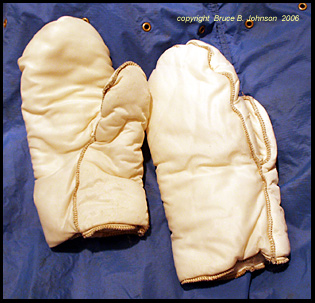

Being located in Idaho in a high mountain valley at the foot of the majestic Tetons led to a lot of cold hands and feet, even to frostbite. The winter climate is brutal, with temperatures often dipping well below zero F... Thus Rivendell's Hot Tamale Mittens and Elf boots were created to fill a distinct gap in the hand and foot protection that existed in the market in the 1970s (see price sheet below for info about such competitors as Dachstein mitts)......
MITTENS: Rivendell called the white mitten liners shown "the meat" of their "DIS" (digital insulation system!)....They are filled with 10 oz/yd. Polarguard synthetic insulation, which is sandwiched between layers of light, silky nylon tricot knit. The mitten liners weigh a mere 3 oz. total, but possess an almost magical property of warmth, feeling "hot" within seconds of inserting ones hands! There is a scientific reason for this, which I discuss below. .....There was also a "Hot Tamale Shell." This sophisticated design used several materials which worked in concert-- the face and thumb were of 8 oz. double coated nylon duck (navy blue color)... The palm and inside of thumb a dense, smooth-skinned neoprene... The back (orange) part was a gorelex nylon oxford. The insides were completely lined with comfortable 65/35 cloth. Together, this Hot Tamale was the best shell I have ever used (unfortunately, I no longer have my shells, so can only post an image taken from the company's 1976 catalog, see below). Contact me: jupiterman47@gmail.com
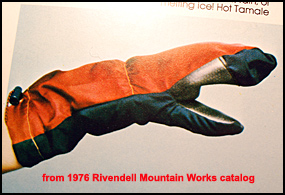
The science of what you wear on your Hands: Why use mittens? Why use Polarguard? Why make the Hot Tamale mitten liner out of that super-light nylon tricot instead of something a lot more rugged and sturdy? Why does this mitten possess such an immediate feeling of heat when placed on the hand? Why do some gloves/mittens just "feel" a lot more warm than others, and why might this be important in not just comfort, but in preventing serious problems like frostbite? How might this help sufferers of Reynaud's disease? Your Questions? Thoughts? Contact me: brucej@Oregonphotos.com
"Thermal Mass".... Home Experiment: take any common glove or mitten and put it into your home freezer. After it has been in there an hour or two, take it out and immediately wear it. Note the distinct and unpleasant feeling of COLD; note that the glove is actually draining away the HEAT of your hand for a period of time before your hand wins and the glove heats up to your hand temperature and begins to subjectively "feel" warm..... Notes: (1) if you can find a test glove that uses leather and that seems to be heavy in terms of weight, the test will have more obvious results; (2) the interior of a typical home freezer will be at about zero degrees F; this is a good test temperature as it approximates the wintertime temperatures of challenging natural environments such as the Northern Rockies or Upper Midwest; (3) for an even more real-life test, before placing the glove or mitten into the freezer, wring out a wet bath towel to get the glove into the approximate state of a glove that has been dampened by playing or working in a snowy winter environment.
The Rivendell Hot Tamale liner was carefully engineered to have an extremely low "thermal mass," and this is one of its secrets. When placed onto a cold hand, it has (1) a high capacity to trap the heat of the enclosed hand, and (2) a very low capacity to steal heat away from the hand; (3) even when dampened by perspiration or external water it retains only a tiny amount of water, and thus dries very rapidly under field conditions with only body heat....see below for an exception to the thermal mass rule.
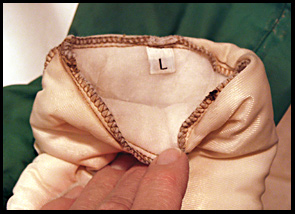 In actual winter camping
conditions, the advantages are obvious---- I arose to a Yellowstone
Park winter morning to find the air temperature at 5 below zero
F. My two sets of hand wear had been in my pack overnight and
they are both chilled to 5 below zero. . One set is my super-comfortable
Conroy leather-goretex ski gloves, and the other set is my Hot
Tamale liner with a simple goretex overmitt shell.. Putting the
Conroy on my hands, I immediately note my hands feeling colder
and colder; I begin to notice my right index finger beginning
to go numb after a few minutes. I run around vigorously and wave
my arms about to encourage circulation. Eventually, my hands win
the battle, and the gloves warm to my hands and finally begin
to protect me from the cold instead of making the frostbite danger
to my hands worse! ....In vivid contrast, pulling on the Hot Tamale
liner produces only the faintest hint of coldness against the
skin, followed almost immediately by a feeling of warmth, gradually
building to a very cozy level even at 5 below!
In actual winter camping
conditions, the advantages are obvious---- I arose to a Yellowstone
Park winter morning to find the air temperature at 5 below zero
F. My two sets of hand wear had been in my pack overnight and
they are both chilled to 5 below zero. . One set is my super-comfortable
Conroy leather-goretex ski gloves, and the other set is my Hot
Tamale liner with a simple goretex overmitt shell.. Putting the
Conroy on my hands, I immediately note my hands feeling colder
and colder; I begin to notice my right index finger beginning
to go numb after a few minutes. I run around vigorously and wave
my arms about to encourage circulation. Eventually, my hands win
the battle, and the gloves warm to my hands and finally begin
to protect me from the cold instead of making the frostbite danger
to my hands worse! ....In vivid contrast, pulling on the Hot Tamale
liner produces only the faintest hint of coldness against the
skin, followed almost immediately by a feeling of warmth, gradually
building to a very cozy level even at 5 below!
Thermal
Mass, part two, compliments of Eric Hardee....
there are always exceptions to any rule. Eric Hardee loves his
pair of heavy wool mittens from Europe called the "Dachstein."
He adds this note illustrating that sometimes thermal mass can
work in reverse. Here's how-- if one's hands have become extremely
cold this often indicates not only possible frostbite danger,
but the physiologic fact that ones body has withdrawn blood circulation
to its core... When this is occurring, it becomes extremely difficult
to re-warm your hands by simply putting on a set of Rivendell
Hot Tamales-- there is just no hand heat for the mittens to trap!
It is in this type of situation that Eric Hardee's suggestion
makes great sense--- Eric wrote, "....after reading your
page, I realized why the Dachsteins work so well for me. I have
poor circulation in my fingers, caused by previous frostnip, and
probably a bit of
Reynods syndrome thrown in. I learned, when I was a climbing ranger
on Mt.
Rainier, that I needed to always have a pair of warm mittens
ready at all times.
When I stop, and particularly when I eat, all the blood flow goes
out of (away from) my hands.
So I would keep my mittens tucked into my pants, held in place
by the pack
hipbelt. Dachsteins have a lot of thermal mass, and so I would
put cold fingers,
that were generating no heat, into warm mittens which would
hold their heat long
enough to let my metabolism ease the blood back into my fingers.
My fingers
actually turn a sickly yellow color. So there are actually some
folks, like myself,
where the lightweight approach doesn't work too well, at least
for rewarming
dead digits! The rest of the time the more modern approach is
a better one.
Thought you might appreciate the perspective."
The Hot Tamale's main competition in the 1970's were the Austrian import called the Dachsteins (made of extremely dense, heavy wool), the (English?) Millarmitt, and the Walker Wool Gloves-- and you can't buy any of them anymore in this country. Below are some amazing prices: (Chouinard catalog, 1973)......
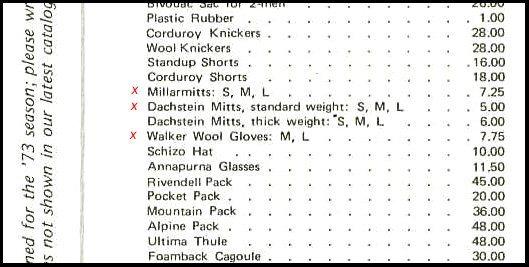
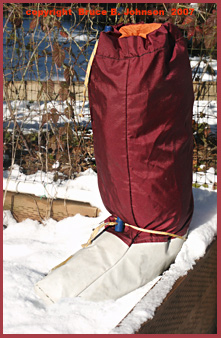 The Elf boot was an advanced overboot specifically
designed to be worn over the fairly lightweight 3-pin binding
("nordic norm") x-c boots of the day. The purpose was
to bring such boots up to par for cross-country skiers and ski
mountaineers operating under the harsh winter conditions of the
Tetons.
The Elf boot was an advanced overboot specifically
designed to be worn over the fairly lightweight 3-pin binding
("nordic norm") x-c boots of the day. The purpose was
to bring such boots up to par for cross-country skiers and ski
mountaineers operating under the harsh winter conditions of the
Tetons.
The Elf Boot's upper was composed of a sturdy oxford nylon Goretex with a tricot backing. The footpiece was made of an unusual vinyl-coated polyester material that was tested as impervious to water even under highly challenging conditions, eg. standing in slushy snow with full body weight encouraging water to leak through. A foam-backed nylon tricot lined the footpiece, providing enough extra insulation to the Elf Boot that even light x-c touring boots were made warm enough for sub-zero Teton winter conditions..As a bonus, the Elf Boot made a superb mukluk when in camp; one simply inserted a pair of down booties for toasty feet even while doing camp chores in the deep powder snow for which the Tetons are justly famous.
On "The Other" side of the Teton Range, in the tourist mecca of Jackson Wyoming, the Carmans set up the Life Link company in 1978... One of Peter Carman's products also had to do with keeping warm feet under brutal Teton conditions. This was the Peter Carman "Supergator," which could be found marketed by Peter's old mentor Yvon Chouinard.
Rivendell also greatly admired the creative, high-quality down sleeping bags of designer George Lamb of Camp 7 and carried their "The System," which was a down/polarguard/vapor barrier modular system (click for more on Camp 7 website).
Please Note: All Material on this page, and in all my "History of Gear" webpages, is copyrighted, and no usage of my material is permitted unless explicit permission is granted by me, Bruce B. Johnson, owner of OregonPhotos.com.(email me: brucej@oregonphotos.com)
In 2006, the Rivendell Eagle dusted off its feathers and took flight again! The good news for modern hikers is that Eric Hardee is producing original Rivendell/Jensen packs on a custom-order basis. Click here for more information.
GEAR ALERT: Rivendell/Jensen packs are now available on a custom basis (see page bottom).
High in the misty Cascade mountains, the dream of Rivendell lived on for many years..Eric Hardee and Don Wittenberger have been "Keepers of the Flame." Eric has had legal use (via Don Wittenberger) of the authentic Rivendell pack blueprints and has been sewing/selling custom Jensen/Rivendell packs via word of mouth advertising for many years.... Eric can sew up a gorgeous original Jensen or Giant Jensen for you--- Contact him! He is a true lover of this pack. His email is ewak3@juno.com. Tell him that you heard about him from Bruce at OregonPhotos.com. ... Eric has a fine Rivendell pack website, see Eric's own Rivendell website.